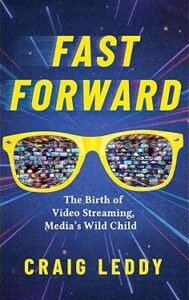What We’re Reading: “Fast Forward: The Birth of Video Streaming, Media’s Wild Child”
 Our bookshelf is overflowing with three industry books releasing this month—John Malone’s “Born to be Wired,” Rouzbeh Yassini-Fard’s “The Accidental Network” and Craig Leddy’s “Fast Forward: The Birth of Video Streaming, Media’s Wild Child.” Malone’s been making the circuit and we have an upcoming interview with Yassini-Fard, so we’ll focus this feature on Leddy’s dive into disruption.
Our bookshelf is overflowing with three industry books releasing this month—John Malone’s “Born to be Wired,” Rouzbeh Yassini-Fard’s “The Accidental Network” and Craig Leddy’s “Fast Forward: The Birth of Video Streaming, Media’s Wild Child.” Malone’s been making the circuit and we have an upcoming interview with Yassini-Fard, so we’ll focus this feature on Leddy’s dive into disruption.
It’s an ambitious project to tackle the birth of video streaming in a mere 242 pages, but Leddy does an admirable job by focusing on Time Warner’s trial of an interactive television service in the 1990s that featured on-demand movies, games and shopping (a sign that email was nascent is that ordering stamps from the U.S. Postal Service was one of the most popular applications). It helps that Leddy was there. Not in the operations center, but one of 300 or so journalists gathered to witness the launch of Time Warner’s Full Service Network, as well as to cover the steps it took to get there.
It’s a chapter of television history that is well worth revisiting, with Leddy offering a unique perspective as a business journalist who covered the project from its inception as well as what came after in his role as an industry educator (he spent years at CTAM and runs the Interactive Case Competition study).
“Although it ultimately was deemed a failure and now is largely forgotten, FSN provided key linchpins in the development of television from a medium of limited analog channels to the digital, interactive and on-demand services today,” writes Leddy.
Fast Forward also serves as a primer on some of the cable industry’s pioneers—Malone, Jerry Levin, Jim Chiddix, Yvette Kanouff and Jim Ludington. There was a lot of push and pull. As Leddy puts it, “Convergence may have been starting to occur between cable and computer technologies, but not necessarily the people behind them.”
For those of us who didn’t live through this experiment or weren’t closely involved in it, Fast Forward is a real time capsule, re-creating the jitters of launch day with its “Oh, Jesus Switch” (which would trigger a back-up network if the main network failed), the Home of the 21st Century (an Orlando house built as a technology showcase) and even the launch day presence of rock musician Todd Rundgren (“Bang the Drum All Day’), who was fronting a nascent music service. There’s a good use of photos—FSN’s video servers that are as large as a refrigerator and the humongous FSN Home Communications Terminals that cost about $4,500 each.
While Leddy’s book is centered on FSN’s launch and demise, he touches on what comes next—cable VOD, TiVo, Slingbox… There’s even a nod to Yassini-Fard, whose LANcity showcased video streaming with a cable modem in 1993. All in all, a fun read that shows not only where the industry has been, but how the lessons of FSN can apply to where it’s headed. – Amy Maclean